PHYS1008 Electric Forces and Fields

|
Outline and objectives:
|
History
Historically: very hard to study electricity. Until 18th Century,
all experiments were done with magnetism (which is easy to do, but even harder
to understand!). | 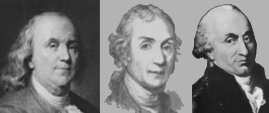
(picture from L. Taylor, Univ. Maryland)
|
| This shows you the kind of experiment that was done |
|
Franklin, Priestly, Coulomb and others found:
- Electricity came in two kinds (resinous and vitreous) which we now call
- positive and negative charges.
- Some materials allow charge to move around (conductors)
- Some materials will hold a charge, but do not allow it to move (insulators)
- Like charges (++ and --) repel, unlike attract (+- and -+).
- Now know that charge is conserved, smallest unit of charge is that on electron
(or proton)
- SI unit is Coulomb, which is a huge amount of charge.
- Charge on electron q = -1.6x10-19 C
Coulomb's law:
inverse square law, like gravitation
\color{red}{
F_G = \frac{{Gm_1 m_2 }}{{r^2 }} \Rightarrow F_E = \frac{{kq_1 q_2 }}{{r^2 }}}
k is just a number (like G): k = 9x109 N m2 C-2, charge is measured in coulombs
Most more advanced books use
k = 1
4πε₀
where
ε₀ = 8.85x10-12 C²N-1m-2
Reason is that more important equations are simpler written in terms of ε₀
- How do we apply this?
-
| e.g. What is force between 2 charges of 5 μC, separated by 20 cm? |
 |
If the electrostatic force is so much stronger than gravity, why don't we feel it?
- Everything we are made of is neutral, so there are no electrostatic forces
- We consist of an equal number of positive charges (protons) and negative (electrons), so the forces cancel out
- Everything on the earth has a small negative charge and the earth has a positive one, so we are attracted to it for this reason
Since F is a vector we need to be careful about directions
\color{red}{
\vec F_{12} = \frac{{kq_1 q_2 }}{{r^2 }}\hat r_{12} }
where \color{red}{\vec F_{12} }
is the force of charge 1 on charge 2, and \color{red}{\hat r_{12} }
is the unit vector that points from 1 towards 2.
- What does Coulombs law mean?
-
| Imagine we have a single fixed charge, and some moveable ones that we can use to measure the force (this is the experiment that Coulomb would like to have done!). a single point charge
|
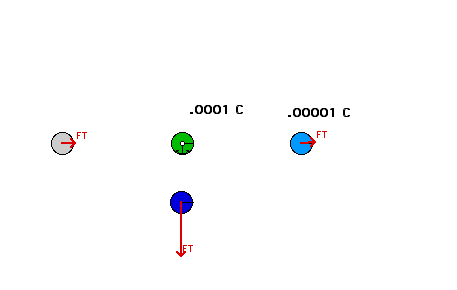 |
The charge on the green ball is 10-4 C, and the charge on the light blue ball is 10-5 C. The magnitude of the forces are 0.25N? What is the charge on the grey ball?
- 10-5C
- 10-4C
- -10-5C
- -10-4C
|
 . . |
The magnitude of the force on the dark blue ball is 1.0N? What is the charge on it, if its distance from the green ball is half that of the light blue ball?
- 10-5C
- 10-4C
- -10-5C
- -10-4C
|
 |
Superposition
| Can add the field due to several charges: for example a case with two equal charges. This is known as "superposition". This shows how it works for a dipole |
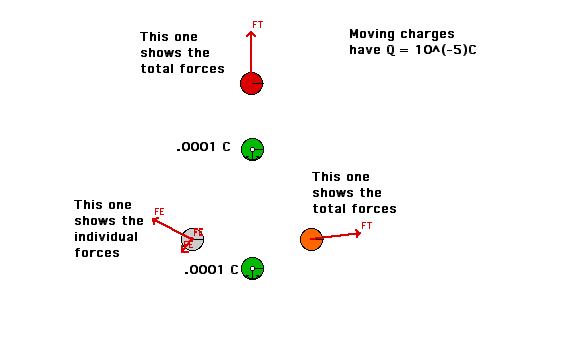 |
The charge on the green ball is 10-4 C, and the 2 grey balls have the same charge of 10-5 C. What is the charge on the white ball? - 10-5C
- 10-4C
- -10-5C
- -10-4C
|
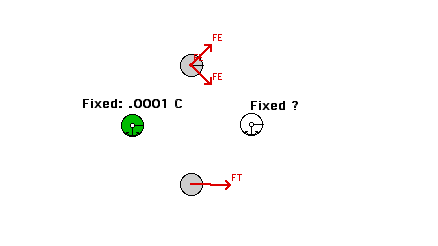 |
Induction
| We can measure charges with a an electroscope:
|
Electric field
- There is "something" that exists whether or not we measure it:
- this "something" is field.
- The relation between the force and field:
F = qE
- Unit for E is Newtons/Coulomb,
- and (exactly the same thing) Volts/metre.
- We can measure the force at a whole lot of places with a test charge:
- For example,
a single point charge
- or a dipole
Lines of Force/Field Lines
| We can also arrange out test charges to sketch out the field. |
If we arrange the charges so that the force vectors line up, we get a diagram
that draws out lines: these are known as "field lines" or "lines of force".
Drawing these lines of force helps us to visualize what will happen to a charge
in an electric field.
- Rules for drawing lines of force:
- Lines start from positive charges
- Lines end on a negative charge
- Lines cannot cross (why)
- Close to a charge, lines go radially outwards (or inwards)
- density of lines represents (roughly) strength of field
|
e.g. a dipole
Franklin http://my.vbe.com/~ppeters/franklin.html
lets us visualize the field:
e.g.
-
| 2 positive charges Is there a place where we can put a charge so it does not feel a force? |
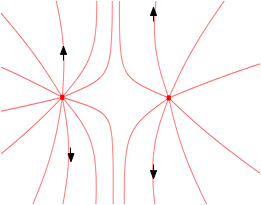 |
- More complicated examples:
-
| charges arranged in a triangle |
 |
| Note that if charges don't "cancel out", some lines will go to infinity |
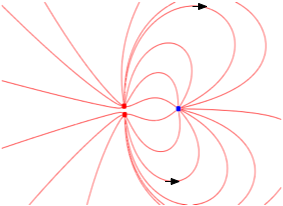 |
| and looked at from large distance, they will look almost like one point charge |
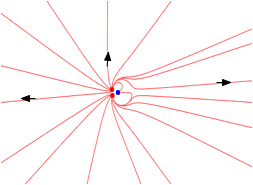 |
Adding Fields
However, we need to be able do this quantitatively: i.e. we need to be able to add the effect of several charges
Some important special cases of electric field:
Point charge (obviously!):
\color{red}{
F = k\frac{{q_1 q_2 }}{{r^2 }} \Rightarrow E = k\frac{{q_1 }}{{r^2 }}}
|
Field due to a dipole (two equal and opposite charges). The total charge is
zero, so would expect this to vanish at large distances. It almost does!
\color{red}{
E = 2k\frac{{qd}}{{r^3 }}}
|
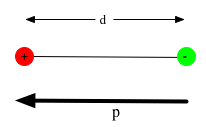 |
| On-axis proof:
\color{red}{E = \frac{{kq_1 }}{{r_1 ^2 }} + \frac{{kq_2 }}{{r_2 ^2 }}}
can simplify \color{red}{ = kq\left( {\frac{1}{{\left( {x + \frac{d}{2}} \right)^2 }} + \frac{{ - 1}}{{\left( {x - \frac{d}{2}} \right)^2 }}} \right)}
so that
\color{red}{E \approx \frac{{2kqd}}{{x^3 }}}
We have used superposition here |
 |
|
If we don't make the large distance approximation, we get this.
Note that the field is most intense (lines are densest) near the charges |
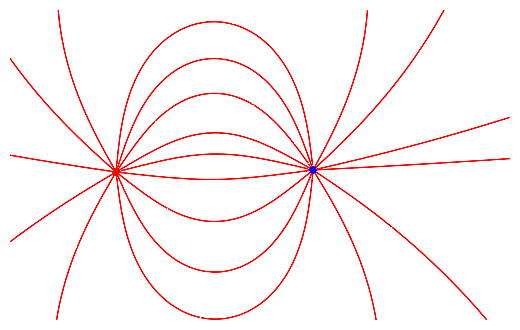 |
Why do we use Electrostatic Fields? We can use the field to visualize what will happen to a charge.
| What is the direction of the force on an electron in a uniform field? |
 |
-
An electron is at rest in a field of 1000 V/m.
- What is its acceleration?
- How long does it take before it is travelling faster than the speed of light?
- Why is the calculation silly?
| e.g. many molecules (such as water) act as tiny dipoles : they are overall neutral, but consist of two (or more) charges separated by
a small distance. Dipole moment
\color{red}{\vec p = q\vec a}
, direction from negative to positive |
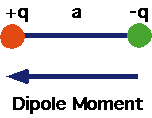 |
An electric dipole is in a uniform electric field. What
will happen to it?
- It will move to the left.
- It will move to the right
- It will rotate counter-clockwise
- It will rotate clockwise
|
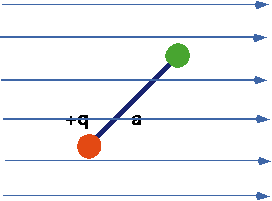 |
Quantitatively:
Electrostatic Field Examples
- What is the field at the 2q charge?
- What will the force
on the 2q charge be if a = 5 cm, q = 2 μC?
- How would the force change if the 2 q charge was moved to the equivalent point on the other side of the dipole?
|
 |
| It is quite a bit harder to do this if we have charges away from a line, because we then need to add up vectors. |
|
e.g.
- What is the field at the origin given the following arrangements of charges?
- What does the field look like?
- Is there any place where a positive charge would feel no force?
|
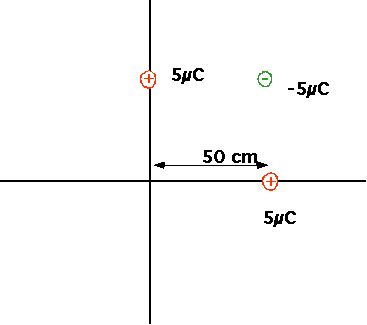 |
Continuous Charge Distributions
Usually we don't have single charges: charge is spread out on in a line or a surface:
|
|
| This is for an infinite flat plate: in reality for a finite disc: |
QuickTime plugin needed for this movie.
This movie © 1996, 1999 Ruth Chabay and Bruce Sherwood.
|
Two flat plates
Very Important.
| Two oppositely charged flat plates: fields will cancel outside them, but add
in between. |
|
-
| giving
\color{red}{E = 4\pi k\sigma = \frac{\sigma }{{\varepsilon _0 }}}
|
 |
Gauss' Law
If we draw a surface round a bunch of charges, the total # of lines of force crossing the surface is the same. (note we have to count lines going in as negative).
- If the number of lines of force from a given charge is taken to be the same, we can measure the total charge by counting the lines of force.
e.g. our old example with charge + 2 and 2 charge -1: How many lines of force pass through the surface
- A
- B
- C
- D
|
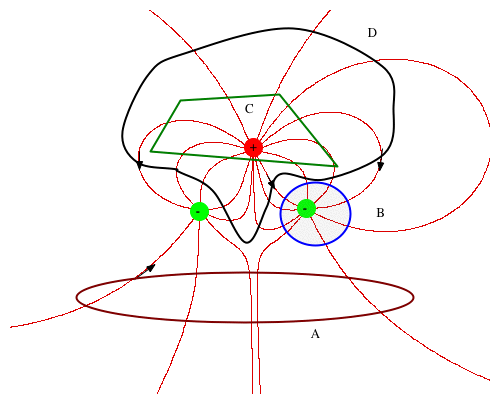
|
Formal way of stating this is Gauss' law: define flux φ of E through the surface (misleading, since nothing flows!).
\color{red}{
\phi = E_ \bot A = EA\cos \left( \theta \right)}
This gives the total charge inside
\color{red}{
\phi = 4\pi kq = \frac{q}{{\varepsilon _0 }}}
This says:
At every point of the surface, find the field, take the component of E ⊥ surface and add these up: the result is ∝ charge inside
Units of flux: [E] Vm-1, so [φ] = Vm.
Sign of flux: for a closed surface, count it as positive when vector E points out.
| Meaning of φ What is it in these 3 cases?
|
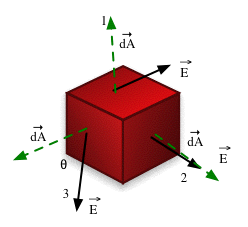 . . |
What is φ in case 1?
- 0
- EA
- -EA
|
 |
What is φ in case 2?
- 0
- EA
- -EA
|
 |
What is φ in case 3?
- 0
- EA sin(θ)
- -EA sin(θ)
- EA cos(θ)
- -EA cos(θ)
|
 |
Gauss' Law is always true, but only useful if we can fix things so that either
\color{red}{\cos \left( \theta \right) = 0}
or \color{red}{\cos \left( \theta \right) = 1}
and E is a constant.
We need some symmetry in the problem to do this.
What does symmetry mean? In this context it means: if we have a charge distribution which gives rise to a field, then if we can move in such a way that the source looks the same, then E will be the same.
Suppose we have a charged cone, as shown. We can move it along the z-axis (a translation), or rotate it about the z-axis (a rotation). Do we expect E to be the same under
- both translations and rotations?
- translations but not rotations?
- neither?
- rotations but not translations?
|

|
e.g point charge, draw a sphere, radius R: E is the same at any point,
\color{red}{
\phi = E_ \bot A = EA = E4\pi r^2 }
- and
\color{red}{
\phi = 4\pi kq = \frac{q}{{\varepsilon _0 }}}
\color{red}{
E = k\frac{q}{{r^2 }}}
- But we knew this!
Field inside a conductor?
-
- Hence if there is a charge on a conductor, it must be on the surface.
Line Charge
Charge/unit length = λ
- Similar argument: Field must be constant and ⊥ surface. Make the Gaussian surface a cylinder: charge contained in the surface is \color{red}{q = \lambda l}
- E only passes thorough cylinder, so that flux
- Hence \color{red}{E = 2k\frac{\lambda }{r}}
|
 |
Hollow Sphere:
Charge entirely on the surface: draw Gaussian surfaces as shown.
- No charge inside, so E = 0
- Outside, spherical symmetry, so exactly like a point charge
|
 |
|
\color{red}{
E\left( r \right) = \left\{ {\begin{array}{*{20}c}
{0\left( {r < R} \right)} \\
{\frac{{kq_1 }}{{r^2 }}\left( {r > R} \right)} \\
\end{array}} \right.}
|
-
-
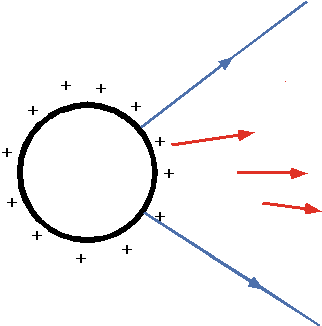 |
- Thre are a few situations (like the hollow sphere) where we need the field, but it's very hard to calculate directly. It is usually much simpler to use
potential than work directly with fields.




 .
. 














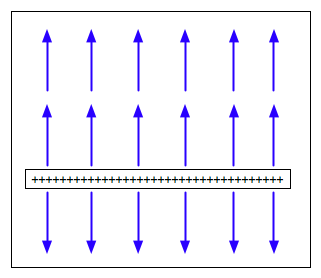


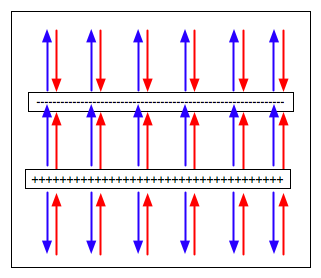
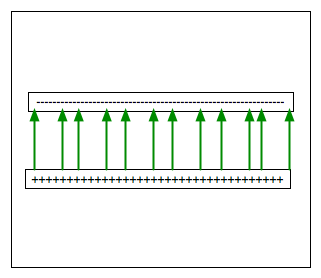


 .
. 









